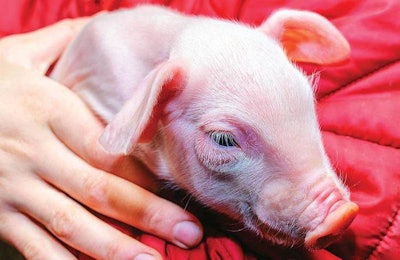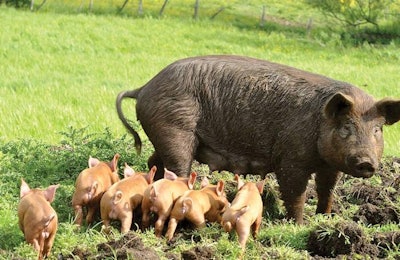
This article appears in the July/August issue of Pig International. View all of the articles in the digital edition of this magazine.
Scours, or diarrhea, are the excretion of feces containing excess fluid. There can be a variety of causes, and therefore a multifaceted approach to prevention is necessary. Piglets are particularly vulnerable to scours as their digestive system is still immature and an upset is more easily triggered. E.coli is one of the most frequent sources, but scours can also be viral, parasitic or nutritional.
Digestive upset
In general, the reason for scouring is an imbalance in the microflora of the gut. For the digestive system to function properly, bacteria are necessary; these beneficial microorganisms help to breakdown the feed and produce nutrients. It is normal for a number of pathogenic (disease-causing) organisms to also be present. However, any changes in the gut can upset the balance between "good" and "bad" bacteria. The result of which is abnormal secretion of liquid and electrolytes into the gut. The ability to digest and absorb nutrients is also affected along with the rate of passage through the digestive tract. Scours may contain mucus, undigested feed or even blood. Damage to the gut takes time to repair, and performance continues to be affected even after scouring has ceased.
Health and production effects
One of the main results of scouring is a reduced ability to absorb nutrients. If the amount gained from the food is not enough to maintain the piglet’s requirements then it has to use its body reserves. At a time when growth rates should be high, if scouring becomes a problem, the piglets will lose weight. In the case of very young animals where reserves are small the resulting exhaustion can cause death. Similarly, dehydration caused by scours can be fatal. If the numbers of pathogenic bacteria multiply quickly they can spread from the gut or release toxins. Death can therefore occur from septicemia or toxemia.
Pathogenic strains of E. coli are the most common cause of scouring in piglets, so strategies to minimize this threat are key.
Loss of a piglet has a significant effect on productive performance, but even if animals survive growth rates will be reduced. During scouring nutrient utilization is reduced, and later on the efficiency with which pigs utilize their food is affected. There is also an influence on long-term health, as secondary infections can occur — pneumonia, for example. Animals that have been weakened by scouring may be more susceptible to future disease challenges.
Types of scouring
- Bacterial: A number of bacteria can be responsible for scours; common culprits are E. coli, Salmonella and Campylobacter.
- Viral: Rotavirus and reovirus can result in scours, along with swine fever and transmissible gastroenteritis.The porcine epidemic diarrhea (PED) virus and the PRRS virus also cause scouring.
- Parasitic: Heavy burdens of both coccidia and worms can cause scouring.
- Dietary or nutritional: Any change in feed can cause scours. Differences in the nutritional specification or material quality can result in digestive upset. Introduction of a new ingredient or even variation in the quantity of feed supplied can also be responsible. Contamination of feed or water also has the potential to affect gastrointestinal function.
Peak times
The causes, severity and symptoms of scours are dependent on the age of the piglet. For example, baby pig scours are characterized by light-colored, foul-smelling liquid scour, which may result in several deaths in a litter. This commonly occurs soon after birth; piglets appear listless and may huddle together.
Diarrhea that occurs at two to three weeks of age is often called pre-weaning or milk scours. Although not normally associated with high mortality, it does result in significant growth set-backs. The immunity acquired from the colostrum has fallen to low levels by this time, although antibodies in the milk offer some protection to the gut.
Treatment
Antibiotic treatment may be necessary for serious cases of scouring. Rehydration therapy, in the form of electrolyte addition to the water, is effective. An oversupply of milk can exacerbate the problem, in which case feed intake for the sow could be reduced during an outbreak.

Ensuring adequate intake of colostrum is important in preventing scours. | Stewairns, Dreamstime.com
The option to move or segregate litters as well as putting piglets in a sickbay can help to reduce the spread of scours. Fostering of piglets from sows with large litters or not enough milk will prevent them becoming too weak. Using an E. coli vaccination before farrowing is a sensible consideration, particularly if there has been a problem in the past.
Prevention
Antibodies from the sow in the form of colostrum are important in preventing scours. Therefore, ensuring that all piglets are suckling well in the first three days of life is very important. This is dependent on both the health of the sow and her piglets. Weak or small piglets may not have the energy to suck or there may not be enough viable teats for the whole litter. Piglets born to sows that aren’t producing enough milk (agalactia) are also at high risk. Other conditions that predispose piglets to scouring include anemia and pneumonia.
While is it important to get piglets eating feed, it must be remembered that their digestive systems are immature and better suited to consuming milk. Diets should contain easily-digestible ingredients, and changes to the composition should be minimized. Undigested feed in the gut creates a breeding ground for pathogens, particularly E. coli.
Making hygiene in the farrowing house a priority will help to reduce the infection pressure. The application of an all-in, all-out system often makes this easier to achieve. Conditions should minimize stress, as this along with other diseases will predispose piglets to scouring. For example, the creep area should be safe, clean, warm and dry.
Conclusions
Pathogenic strains of E. coli are the most common cause of scouring in piglets, so strategies to minimize this threat are key. In terms of digestive stability any sudden changes to feed, water or environment should be avoided. To ensure an adequate intake of quality colostrum, sows should be healthy at farrowing and have had adequate opportunity for exposure to pathogens present on the farm. For the piglets, careful monitoring and rapid intervention will help to reduce mortality.















